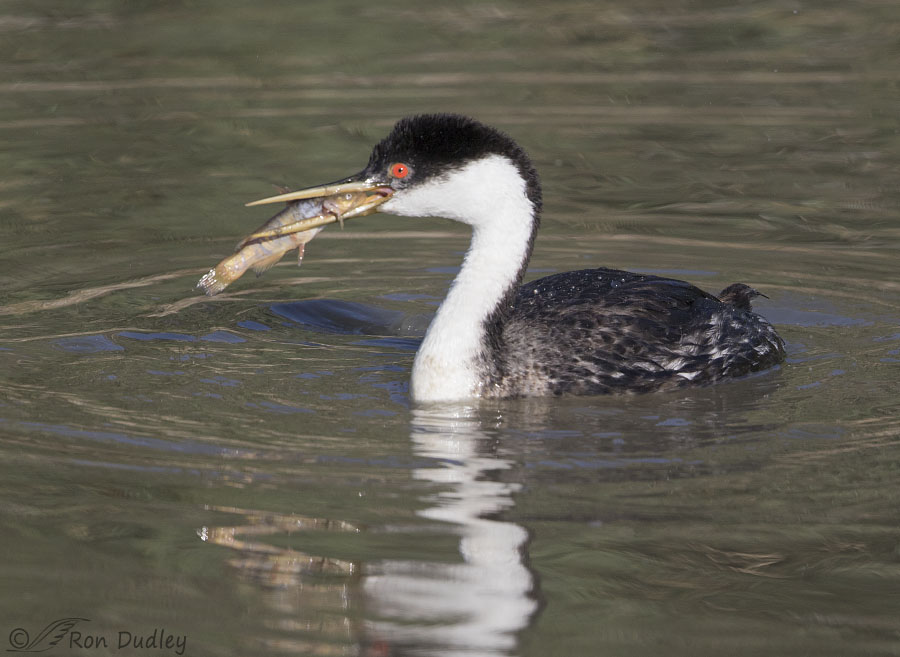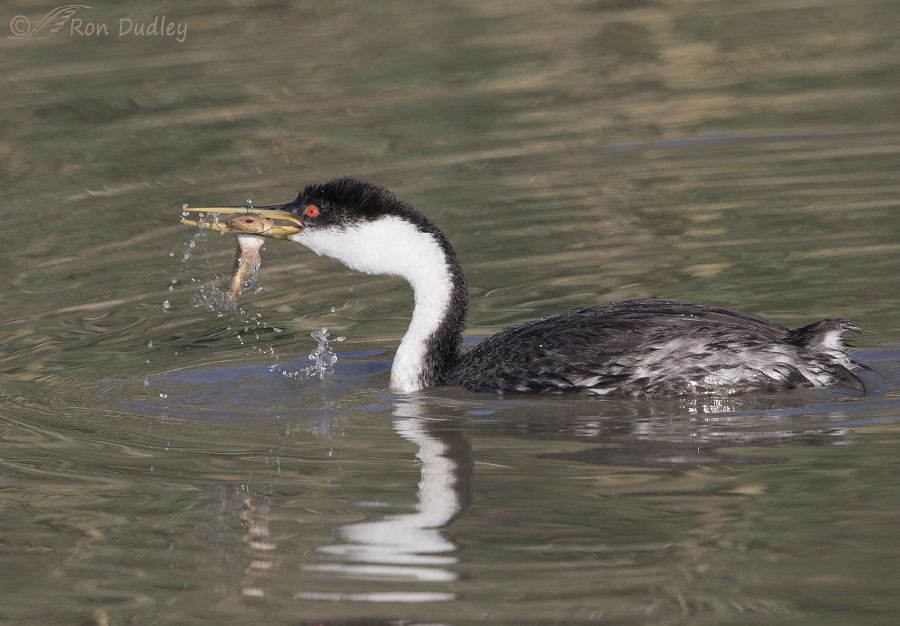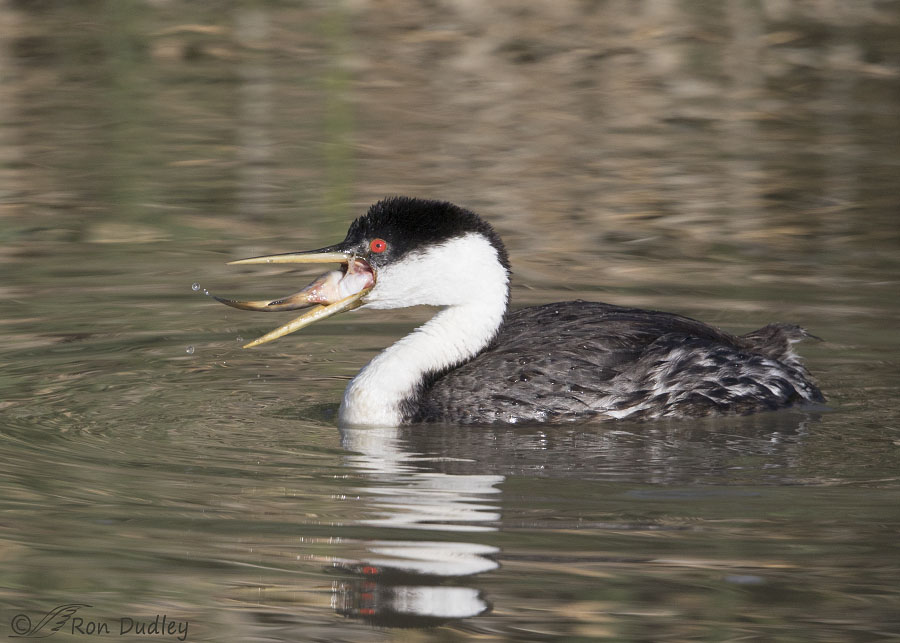Not a good idea! Swallowing a channel catfish whole is almost like swallowing a pincushion with the sharp ends of the pins sticking out.
- I posted several photos of this bird two years ago but these images are new to my blog.

1/3200, f/6.3, ISO 500, Canon EF 500mm f/4L IS II USM + EF 1.4 III Extender, not baited, set up or called in
The two most common types of fish at Bear River MBR are carp and channel catfish. I often see birds at the refuge eating small fish but they’re nearly always carp. But this Western Grebe chose to make a meal out of a catfish and in the end probably wished it hadn’t.

1/2500, f/6.3, ISO 500, Canon EF 500mm f/4L IS II USM + EF 1.4 III Extender, not baited, set up or called in
The grebe spent 8 entire minutes trying to kill the catfish and then swallow it. Time and time again ‘he’ thoroughly mashed its head area with his bill but catfish are notoriously difficult to kill. They have incredibly sharp spines embedded in both their dorsal and pectoral fins that are raised for protection at times of duress and in this case they appeared to be working.
Many fishermen especially in the midwest and south have truly dreadful tales to tell about their encounters with the spines of catfish (maybe we’ll hear a story or two like that in the comments…).
1/3200, f/6.3, ISO 500, Canon EF 500mm f/4L IS II USM + EF 1.4 III Extender, not baited, set up or called in
The grebe attempted to swallow the catfish at least a half-dozen times. I’m confident the difficulty wasn’t the size of the fish, instead it was those dangerous spines. Apparently the grebe could get it down so far and then the spines would interfere with his plans and he would bring the catfish back out and start all over again – mashing the body and especially the head repeatedly in the process.
After 8 minutes I was distracted for a moment and when I got the grebe back in my viewfinder the fish was gone. It happened so quickly I believe the grebe just gave up and released it but I don’t know that for sure.
I suppose it’s possible he somehow managed to swallow it quickly while I wasn’t looking but I doubt it.
Ron



Great photos Ron. Dick’s questions resonate with me, do the birds know which fish to stay clear of? Beautiful bright eyes on the grebe too!
I had a catfish stab me once…once was dnough…can’t imagine trying to swallow one…(unless skinned, coated in flour and cotnmeal and fried)…then they’re pretty darned good!!!
I understand they’re very good eating. For some reason I’ve never partaken.
Great shots!
I wonder if any study was ever made relative diving birds knowing what fish to catch, what fish are difficult to swallow?
Once birds try to eat a Monarch butterfly and regurgitate it, studies have shown they will leave Monarchs and Viceroys, a look alike alone.
However, I suppose when you are hungry you will not be a fussy eater.
Good question, Dick. I don’t know but my guess is that they learn, at least to some degree.
Ouch. Big ouch. Even from this side of the world I wince as I watch.
Me too. I wouldn’t want that thing in my mouth.
I like enlarging the photos to look at the fish. The second photo the fish looks like it has the water knocked right out of it’s mouth.
You’re right, April. It sure does.
Imagine the tale he’ll tell at the barbershop about “the one that got away!”
So now i wonder whether this particular grebe learned not to mess with channel cats. By the way, these fish have some remarkable physiological adaptations. https://en.wikipedia.org/wiki/Channel_catfish.
I wondered the same thing, Martha. Who knows. Yes, I read that Wiki article last night.
As one who has spent my whole life sewing – and had many pincushions – I like your description of the catfish comparing it to a loaded pincushion. At least with the ones I’ve had, what you are describing is the impossible. I hope that that catfish actually did make it down into the Grebe’s gullet, given how much work the bird put into eating it. If he had to let it go, I’m thinking the catfish might have been feeling pretty miserable… I also find it interesting that the barbs on the fins got in the way when the bird was swallowing the fish head first. Those must be some spines on that catfish.
Susan, when the spines are held erect maybe it doesn’t make much difference which way they go down (though birds virtually always swallow fish of any species head first).
Another very interesting series of images! I’ve seen a lot of birds eat catfish and they don’t seem to suffer any ill effects immediately after they swallow them. They may drink a lot of that pink stuff at bedtime. A biologist told me a Great Blue Heron would try to kill a catfish or shake it in order to relax the spines before swallowing. But what about after the fish is in the bird’s stomach? He didn’t have an answer.
Interesting subject!
Thank you for the great photographs.
No real gruesome stories. Dad taught me how to handle catfish when I was very young and that has worked with a LOT of catfish over a LOT of years. I did get stabbed by one when wading, but that wasn’t my fault……
Wally, are your catfish channel cats? From what I’ve read they have among the most menacing spines of all catfish species.
Yes, in our area of central Florida the channel is the most common species. We are also experiencing an influx/invasion of so-called “armored” catfish which I have no experience in handling. Not to mention our saltwater cats which often carry a nasty bacteria on the mucous covering of their skin which can cause really bad things if you get stuck. Like a hypodermic needle infecting you. (Carry long-nosed pliers to de-hook the critters.)
Yikes, those saltwater cats sound scary!
Great series Ron. I could feel myself saying – no no no – let that one go. Painful. Once I was taking photos of a little Pied-billed Grebe who had a fish too big, but tried and tried and tried. I finally gave up and left. And then I had a Great Blue Heron grab the largest catfish I have ever seen and took photos for a half hour while he struggled trying to get that fish to go down. My patience just gave out and I left while he was still working on it.
Everett Sanborn, Prescott AZ
Yup, birds can be persistent while trying to swallow a fish just a little too big. I’ve seen pelicans do it too, and eventually give up.
Watch a Grebe catch and swallow a fish, I thought was too big, took some time but accomplished it. Saw a Great Blue Heron try to swallow a salmon, finally gave up, just no way.
Wonderful series, Ron!! I’m on several Florida & local Facebook pages and have seen photos shared of Herons, Anhingas and Double-breasted Cormorants in the process of “trying” to swallow huge fish, including spiny cat fish. They have to be gutsy to even attempt it. What amazes me is to see how narrow their necks are to think they could even begin to get these huge fish down. It’s amazing how their skinny necks can expand!! Isn’t Nature incredible?!!
Nature sure is, Jo Ann. Thank you.
Yikes! I’ve heard about those spines and guess they could do some terminal damage to the Grebe in the process of trying to swallow/digest one! Grebe sure was mashing it tho…;) Guessing it was VERY hard to give up a good sized meal.
Grebe sure was mashing it tho…;) Guessing it was VERY hard to give up a good sized meal.
Judy, some of the stories fishermen tell about their catfish encounters are gruesome so I can imagine what they could do to much smaller bird like a grebe.